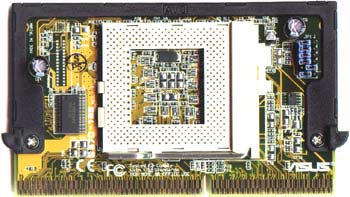
TOP 5 Heat Sinks TOP 5 Low Profile Heat Sinks TOP 5 Liquid Coolers
Heatsinks by Brand / Mfgr Reviews + Articless Advanced Search
 |
TOP 5 Heat Sinks TOP 5 Low Profile Heat Sinks TOP 5 Liquid Coolers Heatsinks by Brand / Mfgr Reviews + Articless Advanced Search |
Asus S370-133 Slocket Overview
The slot-1 motherboard is still king, which is kind of funny if you think about it because hardly any Intel Processors are actually sold in that form factor these days. I guess the general idea is backwards compatibility on the part of the motherboard manufacturers. While slockets are suited to people looking to upgrade their PII or PIII to PPGA or FC-PGA I really doubt anyone buying this card will ever use a Celeron in it. So the Compatibility is nice but not really necessary. The card can acquire temperature data from the processors thermal diode and pass it over to the motherboard and BIOS/software that supports CPU thermal monitoring - an important point if you overclock ;-) The best part by far is the variable V-Core power settings (especially if an older Mother board doesn't support those options through the BIOS) which range from 1.50 volts to 2.60 volts in 0.05 & 0.10 volt increments. Along with the printed documentation, the jumper settings are printed on the back of the card. This is one of those little touches Asus seems to be known for. The worst possible situation would be having a card such as this with jumper settings only printed on a piece of paper that will inevitably get lost somewhere.
Another not so obvious point is that the Asus slocket design is compatible with the MC1000 peltier cooler. Sooo.... if you are one of the lucky people who happen to have that alumium giant in their computer, this card is the choice to move TEC cooling along to the realm of the CuMine. The only modification that needs to be done is to remove the black plastic retainer. I believe Asus slockets were originally chosen by the folks at Swiftech because of the lack of any large dielectric capacitors sticking out. The card has a nice slim design, with only the jumpers sticking out a bit - other then the CPU-socket.  I've been thinking about using this card in particular for its slim design in conjunction with one really large heatsink attached by the screw holes for the black plastic retention clip... A SECC2 sized heatsink could easily be attached that way - avoiding the socket-370 clips entirely... h'mmm I'll have to come back to that one at a latter time. Installation is a snap, the default settings
are set for power and for CopperMine use. I guess that strengthens my argument
about this card probably never seeing a Celeron. Bad things: There is always at least one complaint with something, and mine has to do with the socket-370 asus chose to use. Why they would design a slocket with came lever that interferes with heatsinks when a CuMine is being used is beyond me. There are socket-370's out there with flush cam levers so this problem is avoided. Other then that one shortsighted component this a great little
slocket, with many uses to the novice upgrading a system from a 300Mhz, to the
overclocker trying to squeeze everything out of their 500E and the hard core
Overclocker using a MC1000 to keep things cool. Incidentally the nicely gold plated contacts are much less likely to corrode when they get wet ;-) |
|
||||||||||||||||||||||||||||||||||||||||||||||||||||||||||||||||||||||||||||||||||||||||||||||||||||||||||||||||||||||||||||||||||||||||||
|
Find a Heatsink . Latest Heatsink Reviews . Top 5 Heatsinks Tested . Top 5 Low Profile Heatsinks . Top 5 Liquid Coolers . Heatsinks by Mfgr / Brand |
Social Media |
FrostyTech.com Info . Feedback . Contact Us / Heatsink Submissions . Submit News . Privacy Policy |
 | |
© Copyright 1999-2025 www.frostytech.com All Rights Reserved. Privacy policy and Terms of Use Images © FrostyTech.com and may not be reproduced without express written permission. Current students and faculty of accredited Universities may use Frostytech images in research papers and thesis, provided each image is attributed. | ||||